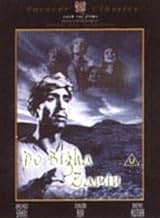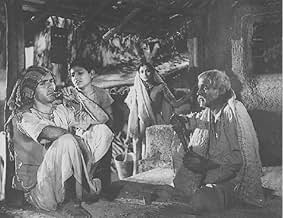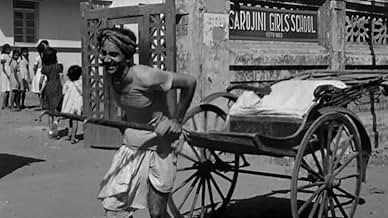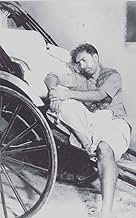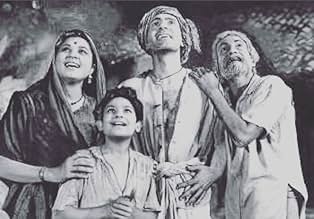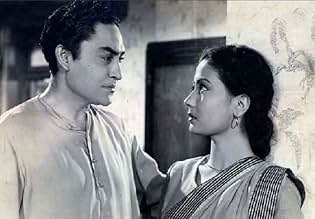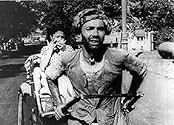VALUTAZIONE IMDb
8,3/10
2406
LA TUA VALUTAZIONE
Aggiungi una trama nella tua linguaIn the hope of earning enough money to pay off his debts and save his land, a poor farmer becomes a rickshaw puller in Calcutta and faces many difficulties.In the hope of earning enough money to pay off his debts and save his land, a poor farmer becomes a rickshaw puller in Calcutta and faces many difficulties.In the hope of earning enough money to pay off his debts and save his land, a poor farmer becomes a rickshaw puller in Calcutta and faces many difficulties.
- Regia
- Sceneggiatura
- Star
- Premi
- 4 vittorie e 1 candidatura in totale
Ratan Kumar
- Kanhaiya Maheto
- (as Rattan Kumar)
Rajlakshmi Devi
- Nayabji
- (as Rajlakshmi)
Nasir Hussain
- Rickshaw puller
- (as Nazir Hussain)
Ramayan Tiwari
- Paro's molester
- (as Tiwari)
Recensioni in evidenza
Made in 1953, with a socialist theme that was typical of many great bengali directors, this was a great film with superlative performances and very real feel to the film. Balraj Sahni, one of the five greatest actors of India ever, was simply stunning in this movie in terms of his natural acting and superior understanding of the life of a peasant first and then a novice rickshaw (two wheel cart pulled by a human, instead of the horse) puller fresh in the city (He naturally doesn't know that once u take a passenger to the destination, u have to hold it down so that the passenger can alight - he nervously waits for his first dime)..Ill have to come back and write more..sorry
This movie is a must see. It shows poverty with a humanistic approach in 1953 India. I went to Calcutta in 1999 and people still ride on human rickshaws (a person runs barefoot on streets while pulling the rickshaws for few cents). It is a very sad. It is heart breaking. In this movie get to see a common man problems and how he or she deals with it. It shows how corrupted the rich are and using the poor for their own means. This is how a 1/3 of India lives in today hi tech India. This is how people are suffering with all the economic boom India has. This is how people live in today's Independent and Free India. This movie is a must see.
After watching the Satyajit Ray films, The Apu Trilogy (1955-1959) and Devi (1960), I decided to check out some of the realistic films directed by other Bengali filmmakers during that same era. One of the films I found was Do Bigha Zamin, which won the International Prize at the 1954 Cannes Film Festival.
Although it's a Hindi-language film, and therefore technically a 'Bollywood' movie, the film's director Bimal Roy is from Bengal, thus the film has more in common with Bengali art cinema than it does with mainstream Bollywood as a result. The film does have a few musical numbers, like a lot of other Hollywood and Bollywood movies of that era, but what sets Do Bigha Zamin apart is its greater sense of realism. Beyond the few musical numbers, the film itself doesn't have much melodrama to it and there isn't much of a background score either, which is a good thing to me as a sappy or sentimental score isn't necessary for a film like this.
Do Bigha Zamin is very much a character-driven drama and the actors did a great job in portraying their respective characters. The performances which stand out most are Balraj Sahni as the farmer Shambu, the protagonist of the story, and the child actor Rattan Kumar as his son Kanhaiya. Nirupa Roy also gave a very good performance as Shambu's wife Paro.
As for Bimal Roy's direction, the film has one of the best depictions of poverty I've ever seen, covering both rural poverty in a Bengali village and urban poverty in Calcutta (now Kolkata), including the plight of street kids living in the city's slums. The film's ending was also powerful and it was overall a very moving film.
8/10
Although it's a Hindi-language film, and therefore technically a 'Bollywood' movie, the film's director Bimal Roy is from Bengal, thus the film has more in common with Bengali art cinema than it does with mainstream Bollywood as a result. The film does have a few musical numbers, like a lot of other Hollywood and Bollywood movies of that era, but what sets Do Bigha Zamin apart is its greater sense of realism. Beyond the few musical numbers, the film itself doesn't have much melodrama to it and there isn't much of a background score either, which is a good thing to me as a sappy or sentimental score isn't necessary for a film like this.
Do Bigha Zamin is very much a character-driven drama and the actors did a great job in portraying their respective characters. The performances which stand out most are Balraj Sahni as the farmer Shambu, the protagonist of the story, and the child actor Rattan Kumar as his son Kanhaiya. Nirupa Roy also gave a very good performance as Shambu's wife Paro.
As for Bimal Roy's direction, the film has one of the best depictions of poverty I've ever seen, covering both rural poverty in a Bengali village and urban poverty in Calcutta (now Kolkata), including the plight of street kids living in the city's slums. The film's ending was also powerful and it was overall a very moving film.
8/10
Post world war II, cinema was deeply influenced by the Italian realist wave. Rosselini and Visconti's hard hitting social commentary and De Sica's day-to-day struggle changed film-making like never before (or since). This wave gave birth to directors like Kurosawa, Fellini and Ray. One of the Indian masterpieces of those days was Bimal Roy's Do Bigha Zamin, which can arguably be termed as the Indian answer to De Sica's The Bicycle Thief.
This film has it's heart in the right place. The indivisible nature of the family, all of whose members work towards the fulfillment of a single objective, which is the fabric of Indian society, is the beauty of the film. All of the members- Shambhu, his wife, his father and son, intend to alleviate his situation and try to contribute in every way possible. The film ends in a sad satirical note, which is the principle characteristic of neo-realistic cinema.
Story apart, the most beautiful aspect of the film is the spirit with which on upholding of one's dignity and self esteem in the most perturbing situations. Though, the protagonist, Shambhu could have executed his task easily many ways, he opts for the most ethical choice of all- hard work. It is quite evident that Do Bhiga Zamin has been influenced by (and has influenced) cinema spanning different geographical, linguistic, and social backgrounds, but it still has a firm foot in its culture.
This film has it's heart in the right place. The indivisible nature of the family, all of whose members work towards the fulfillment of a single objective, which is the fabric of Indian society, is the beauty of the film. All of the members- Shambhu, his wife, his father and son, intend to alleviate his situation and try to contribute in every way possible. The film ends in a sad satirical note, which is the principle characteristic of neo-realistic cinema.
Story apart, the most beautiful aspect of the film is the spirit with which on upholding of one's dignity and self esteem in the most perturbing situations. Though, the protagonist, Shambhu could have executed his task easily many ways, he opts for the most ethical choice of all- hard work. It is quite evident that Do Bhiga Zamin has been influenced by (and has influenced) cinema spanning different geographical, linguistic, and social backgrounds, but it still has a firm foot in its culture.
Of course it is true that Do Bigha Zamin is strongly influenced by Vittorio de Sica's neorealist classic Bicycle Thieves (very improperly retitled Bicycle Thief in the English version). But De Sica's film has influenced virtually every realist film (and many non-realist films) ever since the day it first appeared. It is a crucial reference in world cinema and will probably always remain one.
It was of course particularly influential on all the Indian neo-realists of the fifties, including the greatest of them all - Satyajit Ray. Roy, like Ray a Bengali, would have imbibed that influence before ever he abandoned New Theatres in Calcutta to come to Bombay. He is not an especially innovative director. Devdas (1955) for instance is essentially a Hindi remake of a thirties classic of Bengali cinema; other Roy films show an eclectic range of influences. So it is not surprising to find him in Do Bigha Zamin attempting to adapt the style (and to some extent) the structure of Bicycle Thieves to an Indian context.
Once one has admitted that, however, it should not I think be seen as some sort of shameful plagiarism and one can go on to appreciate some of the real plusses of Roy's film. It is true that it is less restrained than the Italian model; Roy piles on the agony in no uncertain terms and tends to oversentimentalize. Note however that he resists any facile optimism...
The adaptation to a rural Indian context alters the politics of the film, concentrating on the issue (a burning issue to this day in rural India) of the cycle of debt and exploitation to which small peasant farmers in India are subjected (a theme that Mehboob Kahn had already explored in his film Aurat and would do again most famously in Mother India in 1957). This is a less subtle theme perhaps than that of De Sica (where in an urban context it is the poor who steal from the poor and prolong the cycle of misery) but it is nonetheless an important one and Roy (and Balraj Sahni who is excellent) paints a convincing picture of village-life and rural values.
Roy very deliberately counterbalances the picture of misery (rural and urban) with examples of solidarity, of the poor helping the poor, whether on the level of the adults or of the street-boys. And perhaps the most touching and most natural part of Roy's film - and something that owes nothing to De Sica - is his portrayal of the street-kids of Calcutta (which very interestingly prefigures Mira Nair's much later Salaam Bombay). Instead of being isolated companions as in the De Sica film, the father and son in Roy's film experience two rather different aspects of urban life and this layering of the story is perhaps Roy's most significant achievement.
Can one put paid once and for all, finally, to this idea that a realistic film or a film showing social awareness is uncharacteristic of Indian cinema (based on an essentially modern image of "Bollywood")? The golden age of Indian cinema (say 1949 to 1964) abounds in realistic films and films which, while not necessarily realistic in a strict sense of the term, show a good deal of social awareness. It is the period that includes the most memorable films of Satyajit Ray, Rithwik Gathak and Tapan Sinha, the films of Guru Dutt, the early films of Raj Kapoor, those of Bimal Roy, Mehboob Kahn's Mother India but also amongst relatively minor films, Arora's Boot Polish and B R Chopra's Naya Daur. To say nothing of great films in a non-realistic genre such as Mughal-e-Azam (1960) and Pakeezah (largely filmed during the period although not completed until 1972). By comparison with any contemporary cinema anywhere in the world including certainly American cinema, including even that of Japan (also experiencing something of a golden age at that time), it is a very impressive record.
Roy may not be amongst the first rank of cinematic geniuses - I would not put him in the same class as Ray or Gathak or for that matter as Guru Dutt, in my view the finest of the Hindi film directors of the period. He was a populariser (quite determinedly so) and constituted as such an important bridge between the more 'arty' Bengali and more 'popular' Hindi film industries of the time. His contribution remains an important and enduring one to an Indian cinema (and a popular Indian cinema) of real quality that has nothing to do with "Bollywood"...
It was of course particularly influential on all the Indian neo-realists of the fifties, including the greatest of them all - Satyajit Ray. Roy, like Ray a Bengali, would have imbibed that influence before ever he abandoned New Theatres in Calcutta to come to Bombay. He is not an especially innovative director. Devdas (1955) for instance is essentially a Hindi remake of a thirties classic of Bengali cinema; other Roy films show an eclectic range of influences. So it is not surprising to find him in Do Bigha Zamin attempting to adapt the style (and to some extent) the structure of Bicycle Thieves to an Indian context.
Once one has admitted that, however, it should not I think be seen as some sort of shameful plagiarism and one can go on to appreciate some of the real plusses of Roy's film. It is true that it is less restrained than the Italian model; Roy piles on the agony in no uncertain terms and tends to oversentimentalize. Note however that he resists any facile optimism...
The adaptation to a rural Indian context alters the politics of the film, concentrating on the issue (a burning issue to this day in rural India) of the cycle of debt and exploitation to which small peasant farmers in India are subjected (a theme that Mehboob Kahn had already explored in his film Aurat and would do again most famously in Mother India in 1957). This is a less subtle theme perhaps than that of De Sica (where in an urban context it is the poor who steal from the poor and prolong the cycle of misery) but it is nonetheless an important one and Roy (and Balraj Sahni who is excellent) paints a convincing picture of village-life and rural values.
Roy very deliberately counterbalances the picture of misery (rural and urban) with examples of solidarity, of the poor helping the poor, whether on the level of the adults or of the street-boys. And perhaps the most touching and most natural part of Roy's film - and something that owes nothing to De Sica - is his portrayal of the street-kids of Calcutta (which very interestingly prefigures Mira Nair's much later Salaam Bombay). Instead of being isolated companions as in the De Sica film, the father and son in Roy's film experience two rather different aspects of urban life and this layering of the story is perhaps Roy's most significant achievement.
Can one put paid once and for all, finally, to this idea that a realistic film or a film showing social awareness is uncharacteristic of Indian cinema (based on an essentially modern image of "Bollywood")? The golden age of Indian cinema (say 1949 to 1964) abounds in realistic films and films which, while not necessarily realistic in a strict sense of the term, show a good deal of social awareness. It is the period that includes the most memorable films of Satyajit Ray, Rithwik Gathak and Tapan Sinha, the films of Guru Dutt, the early films of Raj Kapoor, those of Bimal Roy, Mehboob Kahn's Mother India but also amongst relatively minor films, Arora's Boot Polish and B R Chopra's Naya Daur. To say nothing of great films in a non-realistic genre such as Mughal-e-Azam (1960) and Pakeezah (largely filmed during the period although not completed until 1972). By comparison with any contemporary cinema anywhere in the world including certainly American cinema, including even that of Japan (also experiencing something of a golden age at that time), it is a very impressive record.
Roy may not be amongst the first rank of cinematic geniuses - I would not put him in the same class as Ray or Gathak or for that matter as Guru Dutt, in my view the finest of the Hindi film directors of the period. He was a populariser (quite determinedly so) and constituted as such an important bridge between the more 'arty' Bengali and more 'popular' Hindi film industries of the time. His contribution remains an important and enduring one to an Indian cinema (and a popular Indian cinema) of real quality that has nothing to do with "Bollywood"...
Lo sapevi?
- QuizWhen the shoeshine boys discuss seeing Nargis in Awaara (1951), one of them alludes to a shirt worn by a bystander. The shirt is decorated with a recurring pattern showing the famous scene from Awaara (1951) in which Raj Kapoor comes upon Nargis as she is changing clothes, partially hidden by a screen, after swimming. That scene occupies a place in Hindi cinema comparable to that of Deborah Kerr and Burt Lancaster on the beach in Da qui all'eternità (1953).
- ConnessioniFeatured in Century of Cinema: And the Show Goes On: Indian Chapter (1996)
- Colonne sonorehariyaala saawan dhol bajaata aaya
Sung by Lata Mangeshkar, Manna Dey
I più visti
Accedi per valutare e creare un elenco di titoli salvati per ottenere consigli personalizzati
- How long is Do Bigha Zamin?Powered by Alexa
Dettagli
- Tempo di esecuzione2 ore 11 minuti
- Colore
- Proporzioni
- 1.37 : 1
Contribuisci a questa pagina
Suggerisci una modifica o aggiungi i contenuti mancanti

Divario superiore
By what name was Due ettari di terra (1953) officially released in Canada in English?
Rispondi

